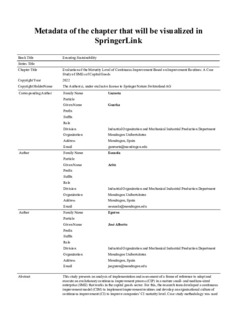Título
Evaluation of the Maturity Level of Continuous Improvement Based on Improvement Routines: A Case Study of SMEs of Capital GoodsFecha de publicación
2022Versión
PostprintTipo de documento
Contribución a congresoContribución a congresoIdioma
InglésDerechos
© 2022 The Author(s), under exclusive license to Springer Nature Switzerland AGAcceso
Acceso embargadoFin de la fecha de embargo
2023-05-31Versión de la editorial
https://doi.org/10.1007/978-3-030-95967-8_23Publicado en
Ensuring Sustainability. Lecture Notes in Management and Industrial Engineering. Pp. 257–266. Springer, 2022Editorial
SpringerPalabras clave
continuous improvement processContinuous improvement routines
Continuous improvement maturity level
industrial case study
Resumen
This study presents an analysis of implementation and assessment of a frame of reference to adapt and execute an evolutionary continuous improvement process (CIP) in a mature small- and medium-sized e ... [+]
This study presents an analysis of implementation and assessment of a frame of reference to adapt and execute an evolutionary continuous improvement process (CIP) in a mature small- and medium-sized enterprise (SME) that works in the capital goods sector. For this, the research team developed a continuous improvement model (CIM) to implement improvement routines and develop an organisational culture of continuous improvement (CI) to improve companies’ CI maturity level. Case study methodology was used in the investigation, where, in the same context, eight units of the aforementioned company were analysed for two years to have a holistic view of the organisation’s evolution. To analyse the implementation of the CIP, we developed an evaluation system based on a questionnaire completed by the company’s management and CI leaders. The assessment results explain how the implementation of the CIM through the application of the CIP helps develop improvement routines and increase the organisation’s CI maturity level. In this specific case, the application of the assessment system shows that although the assimilation of the routines evolved positively in most cases, not in all routines maturity level 2 was achieved, thus emphasising the needs of the organisation and the future actions to be implemented during the following CIP cycles. [-]
Colecciones
- Congresos - Ingeniería [436]
Ítems relacionados
Mostrando ítems relacionados por Título, autor o materia.
-
DFA-SPDP, a new DFA method to improve the assembly during all the product development phases
Ezpeleta, Iñigo; Justel Lozano, Daniel; Bereau Mutuberria, Unai; Zubelzu Lacunza, Julen (Elsevier B.V., 2019)Design for Assembly (DFA) methodologies help the designer to take into account the assembly process during the development phases of a product (specifications, conceptual design and detailed design), thus improving the ... -
Continuous improvement framework to develop cultural change: case study, capital goods company
Unzueta, Gorka; Esnaola, Aritz; Eguren, Jose Alberto (Emerald Publishing Limited, 2020)In this study, a frame of reference was developed to adapt and execute a continuous improvement process (CIP) for reinforcing a continuous improvement (CI) culture in an organisation. The study was undertaken in a mature ... -
Framework to evaluate continuous improvement process efficacy: a case study of a capital goods company
Unzueta, Gorka; Esnaola, Aritz; Eguren, Jose Alberto (2020)Purpose: This document describes a continuous improvement process assessment system (CIPAS). A continuous improvement process (CIP) was developed to progress through the levels of continuous improvement (CI) defined by ...





















